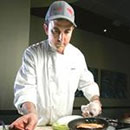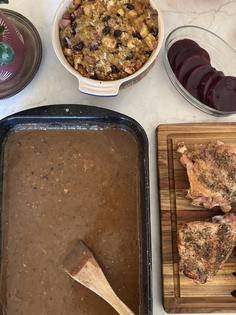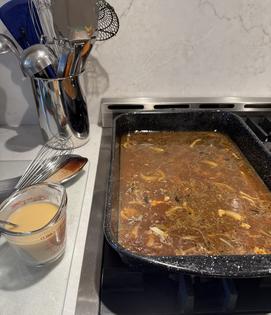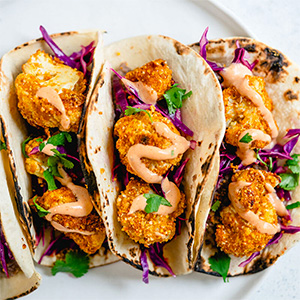Every meal needs a gravy guru
A properly made pan gravy rescues any meal, especially holiday. This golden sauce infuses moisture and flavor to everything it touches — from turkey to stuffing and potatoes. We savor dipping bread or the edge of a biscuit into the rich pool on our plates. It’s worth every calorie.
The drip pan beneath the roasted turkey holds concentrated flavor. Preserve it from burning or accidental disposal — it forms the foundation for superior gravy. If you grill the turkey, be sure to set a drip pan on the rack beneath the bird to collect juices. Even these smoky pan juices can start a memorable gravy--just ensure they’re not overly smoky.
I’ve made buckets of turkey gravy in my lifetime. Over the years, I’ve come to rely on several tricks and tips for success:
1. Start with a delicious broth. Create or purchase a top-quality broth, preferably one that is low in sodium. The broth can be made from chicken, but it’s easy to make a turkey broth ahead of feast day. Here’s how:
Remove the neck and giblets pack from your uncooked, thawed holiday bird. (Or, purchase a couple of turkey wings.) Put the wings, neck and giblets (not the liver) into a large deep saucepan. Add cold water to cover by two inches, usually 1 1/2 quarts. Add a small chopped onion, 1 chopped carrot, 1 chopped celery stalk and a couple of bay leaves to the pan. Heat to a boil. Reduce heat to very low. Simmer, stirring often and adding water if needed, about two hours. Strain into a bowl and discard solids. You should have about 4 cups broth total. Refrigerate broth for up to three days or freeze for several months.
2. Prepare your gravy thickener. Choose from flour (most traditional), cornstarch (for the glossiest gravy) or arrowroot (least amount of thickener flavor). Then dissolve the thickener in cold broth to make a smooth slurry. For flour, a ratio of 1/3 cup to 1 cup broth works well to make 4 cups gravy.
3. Degrease the pan drippings. When the turkey is done cooking, set it aside on a cutting board or sheet pan and tent it with foil. Inspect the roasting pan: If there’s a lot of shiny fat on the surface, use a small ladle to spoon it off into a bowl. Leave all the browned goodness and any liquid in the pan.
4 Deglaze the pan. Set the roasting pan with the degreased pan juices over a burner set to medium. When the pan juices start to boil, deglaze the pan by pouring in a flavoring medium, such as dry red or white wine, dry sherry, dry port or marsala, brandy or unfiltered apple cider (for a non-alcoholic version). Let the mixture come to a boil, then use a flat-edged wooden spoon or silicon spatula to scrape up all the crusty bits left by the turkey. Cook, stirring almost constantly, until the liquids have concentrated and reduced by half. Then stir in the turkey or chicken broth and return the liquids to a boil.
5. Gradually thicken the gravy. When the liquid boils, slowly whisk in the prepared thickener. Keep whisking (to prevent lumps) until the mixture thickens and boils. Reduce heat to low. If desired, add a small spoonful of gravy darkener for a deeper-colored sauce.
6. Flavor the gravy. With the pan juices nicely brothed out and thickened, this is the time to season it all. Taste the mixture and add salt and pepper as desired. A good gravy has a bit of a peppery kick and enough salt to season anything it’s poured over.
Enhance flavor as you wish. A splash of balsamic vinegar, for example, cuts the richness. Caramelized onions and/or mushrooms add texture and sweetness. A spoonful of truffle butter imparts its unique flavor and aroma. A sprinkle of hot chile powder gives heat and rustic aroma.
7. Serve gravy piping hot. A hot spoonful of gravy gently warms turkey that may have cooled during carving. Hot gravy also brings food on a buffet plate back to life.
Basic Turkey Gravy with Wine and Black Pepper
Makes about 4 cups
Note: The following recipe makes a generous 4 cups of gravy using the pan juices from a 10- to 20-pound turkey. Leftover gravy freezes well.
1/3 cup all-purpose flour (or 1/4 cup cornstarch or arrowroot)
4 cups broth, preferably turkey or chicken
Pan drippings (still in the metal roasting pan) from 1 turkey
1 small onion, halved, thinly sliced
1/4 cup dry red wine, port wine or brandy
1/2 teaspoon each: poultry herbs, salt, freshly ground black pepper
2 tablespoons butter or truffle butter, softened
Gravy darkener, optional
1. Put flour into small bowl. Stir in 1 cup of the broth until smooth.
2. Skim off and discard excess fat from the turkey roasting pan drippings. Set the roasting pan with the pan juices directly over the burner. Add the onion and cook on medium-low until softened, about 4 minutes.
3. Increase the heat and add the wine. Boil hard until wine reduces by half, about 2 minutes. Stir in the remaining 3 cups of the broth.
4. Gradually whisk the dissolved flour mixture into the simmering liquid. Whisk constantly until boiling and thickened. (Add water or more broth if needed to adjust consistency). Season with poultry herbs, salt and pepper. Taste and adjust seasonings.
5. Swirl in butter and stir until melted. If desired, stir in a spoonful of gravy darkener for a richer color. Remove from heat and pour into a serving dish.
(JeanMarie Brownson is a James Beard Award-winning author and the recipient of the IACP Cookbook Award for her latest cookbook, “Dinner at Home.” JeanMarie, a chef and authority on home cooking, Mexican cooking and specialty food, is one of the founding partners of Frontera Foods. She co-authored three cookbooks with chef Rick Bayless, including “Mexico: One Plate at a Time.” JeanMarie has enjoyed developing recipes and writing about food, travel and dining for more than four decades.)
©2025 JeanMarie Brownson. Distributed by Tribune Content Agency, LLC.














Comments